AMSAT is a name for various amateur radio satellite organizations worldwide. In particular, it often refers to the Radio Amateur Satellite Corporation, headquartered in Washington, D.C. AMSAT organizations design, build, arrange launches for, and then operate (command) satellites carrying amateur radio payloads, including the OSCAR series of satellites. Other informally affiliated national organizations exist, such as AMSAT Germany (AMSAT-DL) and AMSAT Japan (JAMSAT).

FalconSAT is the United States Air Force Academy's (USAFA) small satellite engineering program. Satellites are designed, built, tested, and operated by Academy cadets. The project is administered by the USAFA Space Systems Research Center under the direction of the Department of Astronautics. Most of the cadets who work on the project are pursuing a bachelor of science degree in astronautical engineering, although students from other disciplines join the project.

Soyuz-2 is a modernised version of the Soviet Soyuz rocket. In its basic form, it is a three-stage launch vehicle for placing payloads into low Earth orbit. Compared to the previous versions of the Soyuz, the first-stage boosters and two core stages feature uprated engines with improved injection systems. Digital flight control and telemetry systems allow the rocket to be launched from a fixed launch platform, whereas the launch platforms for earlier Soyuz rockets had to be rotated as the rocket could not perform a roll to change its heading in flight.
Egyptian Satellites Co SAE or Nilesat is a company and the name of a series of Egyptian communications satellites. It was established in 1996 by the government of Egypt with the purpose of operating Egyptian satellites and their associated mission control center and ground stations. The company is now listed on the Egyptian Exchange, though remains controlled by the government (c.75%) through the National Media Authority (40%), and other state-owned enterprises (SOEs).
An amateur radio satellite is an artificial satellite built and used by amateur radio operators. It forms part of the Amateur-satellite service. These satellites use amateur radio frequency allocations to facilitate communication between amateur radio stations.
UoSAT-3, also known as UO-14 and OSCAR-14, is a British satellite in Low Earth Orbit. It was built by a spin-off company of the University of Surrey, Surrey Satellite Technology (SSTL) and launched in January 1990 from French Guiana. The satellite functioned as one of a series of OSCAR satellite in orbit around the Earth, as well as observing Earth and performing scientific experiments.
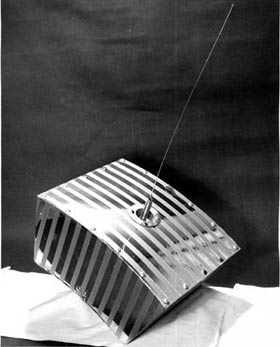
OSCAR 2 is the second amateur radio satellite launched by Project OSCAR into Low Earth orbit. OSCAR 2 was launched June 2, 1962, by a Thor-DM21 Agena B launcher from Vandenberg Air Force Base, Lompoc, California. The satellite, a rectangular box weighing 10 kg (22 lb), was launched as a secondary payload (ballast) for Corona 43, the fifth launch of a KH-4 satellite.

OSCAR 3 is the third amateur radio satellite launched by Project OSCAR into Low Earth Orbit. OSCAR 3 was launched March 9, 1965 by a Thor-DM21 Agena D launcher from Vandenberg Air Force Base, Lompoc, California. The satellite, massing 15 kg (33 lb), was launched piggyback with seven United States Air Force satellites. Though the satellite's active life was limited to sixteen days due to battery failure, OSCAR 3 relayed 176 messages from 98 stations in North America and Europe during its 274 orbit life-time -- the first amateur satellite to relay signals from Earth. As of 2023, it is still in orbit.

OSCAR IV was the fourth amateur radio satellite launched by Project OSCAR and the first targeted for Geostationary orbit on 12 December 1965. The satellite was launched piggyback with three United States Air Force satellites on a Titan IIIC launch vehicle. Due to a booster failure, OSCAR 4 was placed in an unplanned and largely unusable Geostationary transfer orbit.

OSCAR 1 is the first amateur radio satellite launched by Project OSCAR into low Earth orbit. OSCAR I was launched December 12, 1961, by a Thor-DM21 Agena B launcher from Vandenberg Air Force Base, Lompoc, California. The satellite, a rectangular box weighing 10 kg., was launched as a secondary payload (ballast) for Corona 9029, also known as Discoverer 36, the eighth and final launch of a KH-3 satellite.
The Geostationary Satellite for Defense and Strategic Communications is a Brazilian geostationary communication satellite that was built by Thales Alenia Space in France, it was placed in the orbital position of 75 degrees west longitude and will be operated by Telebrás. Telebrás selected Viasat as a partner to help build the associated ground system. The satellite was based on the Spacebus-4000 platform and its life expectancy will be 18 years.
PSAT-2 is an experimental amateur radio satellite from the U.S. Naval Academy, which was developed in collaboration with the Technical University of Brno in Brno, Czech Republic. AMSAT North America's OSCAR number administrator assigned number 104 to this satellite; in the amateur radio community it is therefore also called Navy-OSCAR 104, short NO-104.
OSCAR 8 is an American amateur radio satellite. It was developed and built by radio amateurs of the AMSAT and launched on March 5, 1978 as a secondary payload together with the Earth observation satellite Landsat 3 from Vandenberg Air Force Base, California, United States.
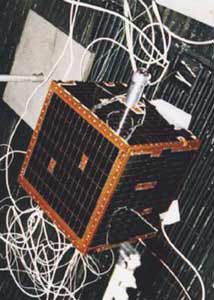
SEDSAT-1 is a U.S. amateur radio satellite built by students and developed at the University of Alabama in Huntsville (UAH).
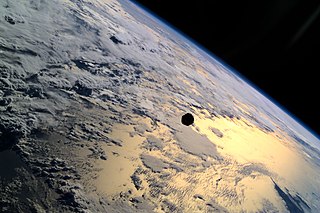
PANSAT was an amateur radio satellite. It was launched by Space Shuttle Discovery during the STS-95 mission as part of the third International Extreme Ultraviolet Hitchhiker (IEH-3) mission, on 30 October 1998 from Kennedy Space Center, Florida.
Eyesat-1 is an American experimental communications microsatellite with an store-dump payload. The mission of Eyesat-1 was experimental monitoring of mobile industrial equipment. Eyesat-1 has provided the National Oceanic and Atmospheric Administration in Silver Spring, Maryland, with communication services to the South Pole. Eyesat-1 carries an FM repeater for Amateur Radio Research and Development Corporation (AMRAD) called AMRAD OSCAR 27 or OSCAR 27.
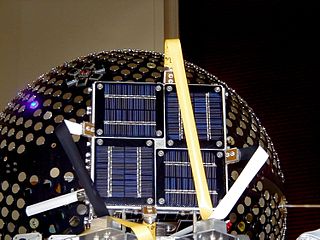
OSCAR 44 is an American amateur radio satellite for packet radio. It was built by Bob Bruninga at the U.S. Naval Academy.
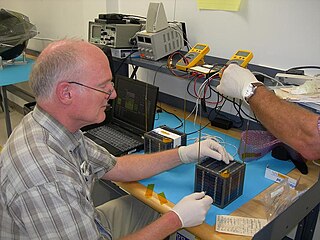
Radar Fence Transponder was an amateur radio satellite that was developed and built for training purposes at the United States Naval Academy. The 3 kg (6.6 lb) heavy RAFT had a cubic structure of 12.7 cm (5.0 in) edge length and therefore did not meet the Cubesat standard. Solar cells on all six sides of the satellite were used to supply energy. It had neither position control nor drive systems.
Sputnik 99 launched on April 2, 1999 from the Baikonur Cosmodrome on board a Soyuz-U-PVB launch vehicle. The nano-satellite was created in a joint-venture by Rosaviakosmos, Aéro-Club de France, and the Radio Amateur Satellite Corporation (AMSAT) as a marketing effort financially backed by The Swatch Group. Sputnik 99 was deployed from the Mir space station on April 16, 1999, even though its primary mission package, an amateur radio broadcast system (AR), had been purposely disabled, immediately rendering the satellite a piece of space flotsam.










